= Rebutia vulpina F.Ritter
Succulenta (Netherlands) 56(3): 66 (1977)
Accepted Scientific Name: Rebutia spegazziniana Backeb.
Kakteen-Freunde ii. No. 1, (1933); Backeb. Blatter Kakteenforsch. 1934, Pr. 2,[p. 8].
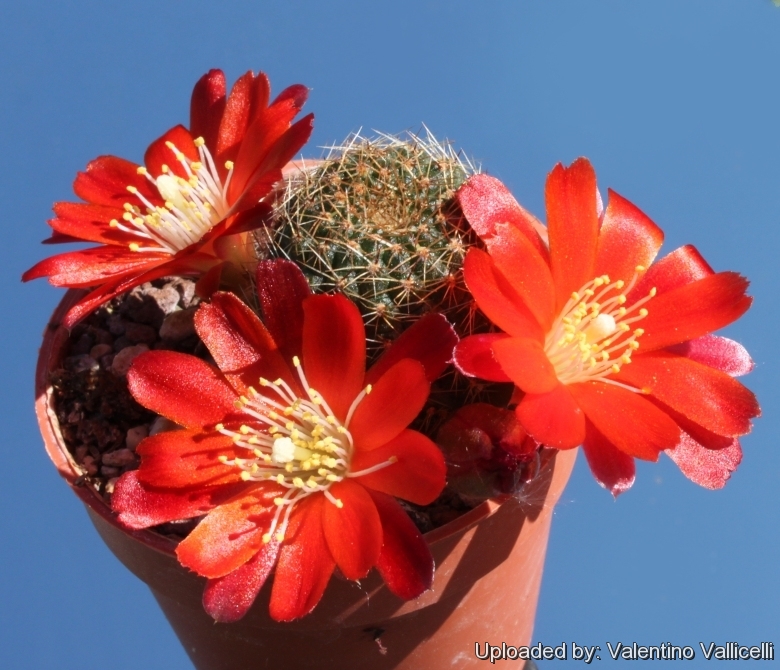
Rebutia vulpes (Rebutia vulpina) Photo by: Valentino Vallicelli
Origin and Habitat: Bolivia (Chuquisaca,Tarija) and argentina (Jujuy, Salta, Catamarca)
Altitude: 3400-3900
Synonyms:
See all synonyms of Rebutia spegazziniana
back
Accepted name in llifle Database:Rebutia spegazziniana Backeb.Kakteen-Freunde ii. No. 1, (1933); Backeb. Blatter Kakteenforsch. 1934, Pr. 2,[p. 8].Synonymy: 35
back
Description: Often misidentified in cultivation, this is a clustering, globular species, with stems 3 to 5cm wide, with about 20 ribs. Areoles have white wool.
Radial spines: 10 to 14, thin, white, standing out, roughened, 3 to 15mm long.
Central spines: 1 to 7, red-brown.
Flowers: Bright red, petals tipped scarlet, stigma white.
Subspecies, varieties, forms and cultivars of plants belonging to the Rebutia spegazziniana group
- Rebutia froehlichiana Rausch
 Rebutia fusca F.Ritter: has tiny bristle spines and vibrant orange-red flower. Distribution: Oruro, Tarija, Bolivia.
Rebutia fusca F.Ritter: has tiny bristle spines and vibrant orange-red flower. Distribution: Oruro, Tarija, Bolivia.- Rebutia mamillosa Rausch: has dark greenish brown bodies becoming bronzed purple in full sun and forms small clumps of small heads around 20 mm across. Flowers dark red, ca. 2,5 cm in diameter with showy white stamens. Distribution: west of Camargo and adjacent areas, Chuquisaca, Bolivia.
 Rebutia mamillosa var. australis F.Ritter: has bodies 20-30 mm wide, 10-15 ribs, 12-20 radial spines, 3-6 mm long and 0-4 centrals equal in length. Flowers 26-46 mm long with white filaments. Distribution: Habitat, San Antonio, Prov. Mendez, Bolivia.
Rebutia mamillosa var. australis F.Ritter: has bodies 20-30 mm wide, 10-15 ribs, 12-20 radial spines, 3-6 mm long and 0-4 centrals equal in length. Flowers 26-46 mm long with white filaments. Distribution: Habitat, San Antonio, Prov. Mendez, Bolivia.- Rebutia mamillosa var. orientalis F.Ritter: has areoles abundantly filled with white wool, 0-4 radial spines, 5-7 mm long, darker at base. Distribution: Tarija towards the south, Bolivia.
 Rebutia patericalyx F.Ritter: has vibrant orange-red flower and tiny bristle spines covered by tiny hairs. Distribution: La Queva, Chuquisaca, Bolivia.
Rebutia patericalyx F.Ritter: has vibrant orange-red flower and tiny bristle spines covered by tiny hairs. Distribution: La Queva, Chuquisaca, Bolivia.- Rebutia rubiginosa F.Ritter
 Rebutia spegazziniana Backeb.: widespread and variable species that will clump with age and produces large and beautiful bright red flowers. Distribution: Bolivia and Argentina.
Rebutia spegazziniana Backeb.: widespread and variable species that will clump with age and produces large and beautiful bright red flowers. Distribution: Bolivia and Argentina. Rebutia spegazziniana var. atroviridis (Backeb.) Šída: has darker bluish grey-green skin and lighter, weaker spines. Blooms dark red. Distribution: Bolivia and Argentina.
Rebutia spegazziniana var. atroviridis (Backeb.) Šída: has darker bluish grey-green skin and lighter, weaker spines. Blooms dark red. Distribution: Bolivia and Argentina. Rebutia spegazziniana var. boliviensis n.n., Rausch
Rebutia spegazziniana var. boliviensis n.n., Rausch- Rebutia sumayana Rausch
- Rebutia tarijensis Rausch
 Rebutia tarvitaensis F.Ritter: has grey-green to olive-green epidermis with violet tints and orange-red blooms. Distribution: Tarvita, Chuquisaca, Bolivia.
Rebutia tarvitaensis F.Ritter: has grey-green to olive-green epidermis with violet tints and orange-red blooms. Distribution: Tarvita, Chuquisaca, Bolivia.- Rebutia tuberosa F.Ritter
 Rebutia vulpina F.Ritter: Flowers are bright red, the petals tipped scarlet, stigma and stamens white. Distribution: Bolivia, Tarija, Mendez, west of Tarija.
Rebutia vulpina F.Ritter: Flowers are bright red, the petals tipped scarlet, stigma and stamens white. Distribution: Bolivia, Tarija, Mendez, west of Tarija.- Rebutia zecheri Rausch
Notes: Rebutia spegazzinianaSN|5033]]SN|5033]] is a widespread and quite variable species that has received an undue number of names.
Bibliography: Major referneces and further lectures
1) Walther Haage “Cacti and succulents: a practical handbook” Dutton, 1963
2) Edward Anderson “The Cactus family” Timber Press, Incorporated, 2001
3) James Cullen, Sabina G. Knees, H. Suzanne Cubey "The European Garden Flora Flowering Plants: A Manual for the Identification of Plants Cultivated in Europe, Both Out-of-Doors and Under Glass" Cambridge University Press, 11/Aug/2011
4) David R Hunt; Nigel P Taylor; Graham Charles; International Cactaceae Systematics Group. "The New Cactus Lexicon" dh books, 2006
5) N. L. Britton, J. N. Rose “The Cactaceae. Descriptions and Illustrations of Plants of the Cactus Family.” Volume 4, The Carnegie Institution of Washington, Washington 1923,
6) Curt Backeberg: “Die Cactaceae: Handbuch der Kakteenkunde” Volume V, Gustav Fischer Verlag, Stuttgart New York 1982–1985
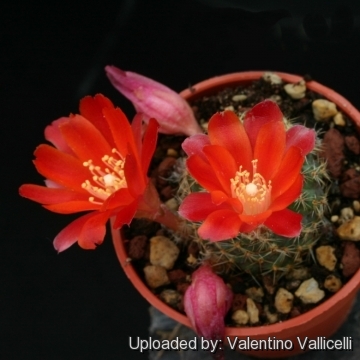 Rebutia vulpes (Rebutia vulpina) Photo by: Valentino Vallicelli
Rebutia vulpes (Rebutia vulpina) Photo by: Valentino Vallicelli Rebutia vulpes (Rebutia vulpina) Photo by: Valentino Vallicelli
Rebutia vulpes (Rebutia vulpina) Photo by: Valentino Vallicelli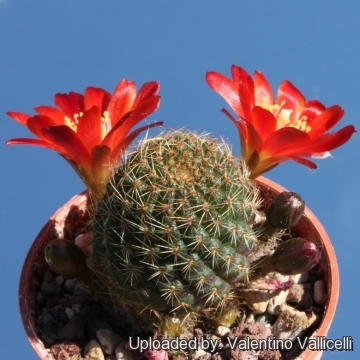 Rebutia vulpes (Rebutia vulpina) Photo by: Valentino Vallicelli
Rebutia vulpes (Rebutia vulpina) Photo by: Valentino Vallicelli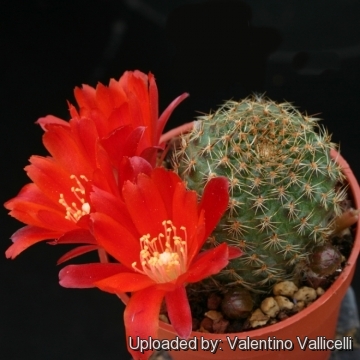 Rebutia vulpes (Rebutia vulpina) Photo by: Valentino Vallicelli
Rebutia vulpes (Rebutia vulpina) Photo by: Valentino Vallicelli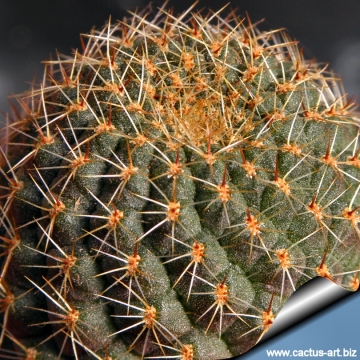 Rebutia vulpes (Rebutia vulpina) Photo by: Cactus Art
Rebutia vulpes (Rebutia vulpina) Photo by: Cactus ArtSend a photo of this plant.The gallery now contains thousands of pictures, however it is possible to do even more. We are, of course, seeking photos of species not yet shown in the gallery but not only that, we are also looking for better pictures than those already present.
Read More... Cultivation and Propagation: Rebutia vulpinaSN|5039]]SN|5039]] is easy to grow and free flowering. Nevertheless, it is appropriate to provide adequate growing conditions in order to obtain abundant blooms.
Growth rate: It is a relatively rapidly growing species that will make large clumps given the best conditions.
Soils: As most Rebutia cultivated for their blossom, it needs a soil mixture a little richer than the average cactus with still an excellent drainage. Prefer a low pH compost, avoid substrata too rich in limestone.
Repotting: This plant needs plenty of space for its roots, repotting should be done every other year or when the it has outgrown its pot. It is rot prone and should be planted in a shallow pot. Use pot with good drainage.
Watering: Needs moderate to copious waterings in summer (it is more demanding than other cactus), but do not overwater, keep dry in winter at a minimum temperature of 0°C.
Fertilization: Feed with a high potassium fertilizer in summer.
Hardiness: It is quite frost resistant if kept dry and hardy to -5° C to -18° C for short periods (depending on varieties and growing conditions). However warmth throughout the year will increase the grower's success (minimum 5° C during rest season).
Exposition: The plant tolerates bright situations which encourages flowering and heavy spine production, but is likely to suffer from sun scorch or stunted growth if over exposed to direct sunlight during the hottest part of the day in summer. It grows well with filtered sunlight or afternoon shade.
Uses: It is an excellent plant for container growing. It look fine in a cold greenhouse and frame or outdoor in a rockery. It is also used as a rootstock for grafting delicate and slow growing cactus species.
Pests & diseases: It may be attractive to a variety of insects, but plants in good condition should be nearly pest-free, particularly if they are grown in a mineral potting-mix, with good exposure and ventilation. Nonetheless, there are several pests to watch for:
- Red spiders: Red spiders may be effectively rubbed up by watering the plants from above.
- Mealy bugs: Mealy bugs occasionally develop aerial into the new growth among the wool with disfiguring results, but the worst types develop underground on the roots and are invisible except by their effects.
- Scales: Scales are rarely a problem.
- Rot: This species is particularly easy and accommodating, seldom suffer of cryptogamic diseases. Rot it is only a minor problem with cacti if the plants are watered and “aired” correctly.
Propagation: Direct sow after last frost, offsets (if available) . Seeds germinate in 7-14 days at 21-27° C in spring, remove gradually the glass cover as soon the plants will be well rooted (ca 1-2 weeks) and keep ventilated, no full sun for young plants! To make a cutting twist off a branch and permit it to dry out a couple of weeks, lay it on the soil and insert the stem end partially into the soil. Try to keep the cutting somewhat upright so that the roots are able to grow downward.















